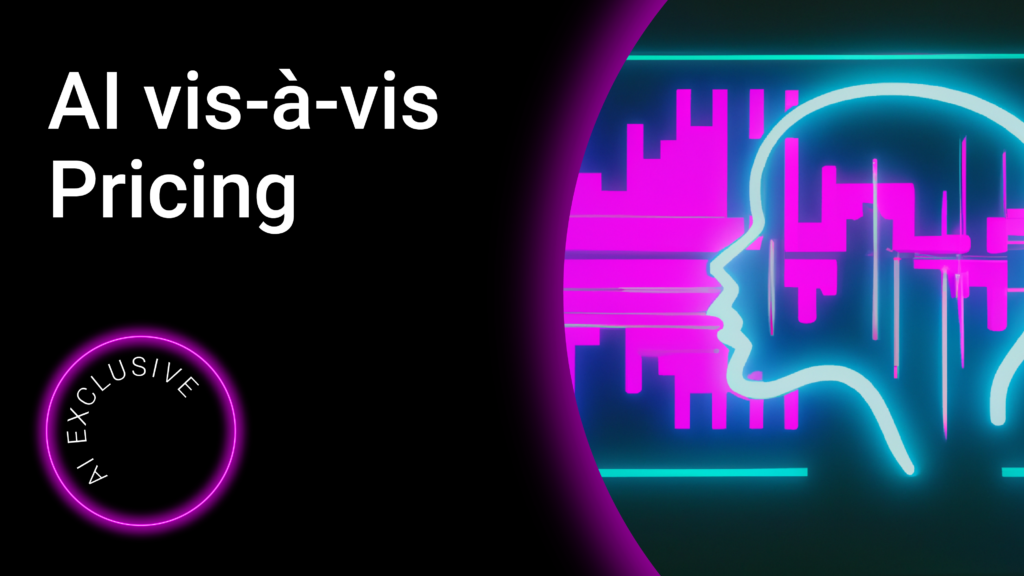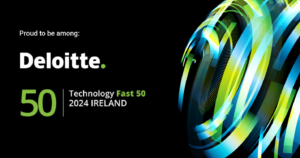The cover story of the July-August 2023 issue of the Harvard Business Review heralds “GenAI and the New Age of Human Creativity” and asserts that “GenAI’s greatest potential is not in replacing humans; it is to assist humans in their individual and collective efforts to create hitherto unimaginable solutions.”
No one should underestimate the personal risks from generative artificial intelligence (GenAI) such as job losses, diminished decision-making authority, and loss of control over processes as the machinery takes on a life of its own. But in this paper, we would like to focus on another area of uncertainty: how AI in all of its forms – from GenAI to machine learning to advanced algorithms – will alter the future of pricing.
Neither the word “price” nor the word “value” appears anywhere in the HBR cover story, a clear indication that companies may be neglecting that challenge. This is surprising, because we have no doubt that GenAI can unlock tremendous innovative potential when it comes to value. But it also has significant hidden risks. Left unchecked, GenAI can kill the “wow” in marketing because it reinforces sameness instead of creating differentiation. These technologies trap people in slowly shrinking black boxes that can no longer see the vast commercial opportunities that lie outside them.
In other words, black boxes can kill the “wow” precisely because they can’t think outside the box.
How AI can strongly influence value and pricing...
AI improves an idea’s time to market, because it improves a company’s time to insights. That may be its biggest potential contribution to value and pricing. By taking full advantage of AI, a company can take a better product to market faster with more confidence that its value messages and its price points will resonate with customers.

This power comes from the complex and nuanced nature of pricing and the levers AI could influence. Pricing quantifies the value of ideas and expresses that value in monetary terms by building bridges between the fascinating freedom of qualitative thinking and the rigid and deterministic world of quantitative thinking.
At the same time, pricing builds bridges between the seemingly irrational and rational sides of business. Think of even simple examples such as charm prices (charging 99 cents vs. $1.00) or the difference between charging someone a penny for something vs. giving it away for free. In each case, the perceived differences between those prices far outweigh their objective or quantitative difference, which is one cent in both cases.
These bridges are where a company’s insights about its customers, its competitors, and its offerings all come together. GenAI can have far-reaching implications for how companies find hard-to-see patterns, craft value propositions, and take products and services to market. On the quantitative side, AI and machine learning have well-established powers to help companies find optimal price points in retail and other sectors, as this 2022 article in The Economist describes.
... and why that is dangerous
Despite that vast potential, there are downsides to AI-based pricing that reinforce the need for human intervention and judgment, rather than diminish it or eliminate it. The two most significant risks of applying AI to pricing are the loss of differentiation and the loss of what we call “irrational advantages.”
Put another way, the more that people use broadly similar tools to access similar pools of data and information, the more their outcomes will converge into narrow bands that have two fundamental constraints. First, the analyses and outcomes are limited by patterns in history, which will have a natural tendency toward convergence rather than divergence. Second, the analyses and outcomes will neither acknowledge nor reflect the power of the innate human biases that behavioral economics has exposed.
We believe that success in pricing – and therefore success in business – lies outside these bands of convergence, not within them. Before we explore the world outside these bands of convergence, we will look at why they exist in the first place.
Black boxes can’t think outside the box
We agree generally with the sentiment that AI will change and often enhance many jobs rather that replace them. The risk we see, however, is that the people in those enhanced jobs will converge in terms of skills, work scope, and the output of their work. As an article in The Atlantic in October 2022 stated: “When universal smarts lead to universal strategies, it can lead to a more homogeneous product.”

The last two decades of Hollywood movies and US sports (especially baseball) show that this tendency toward analytical sameness and copy-cat strategies is a more of a universal phenomenon, and not one limited to marketing or pricing. We cite these two examples not as a warning against the use of analytics and AI, but rather against the risks of analytical convergence that can lead strategists to ignore the opportunities that exist in outliers, anomalies, or counterintuitive approaches.
Let’s start with movies. Comb the list of the top grossing movies of the 21st century and you will quickly notice that almost all of them involve either superheroes, sequels, or re-releases of previous blockbuster films. In 2023, however, two original films broke out of those narrow lanes and helped make one weekend in July largest opening movie weekend ever that didn’t include a Star Wars film. “Barbie” and “Oppenheimer” – or “Barbenheimer” as social media nicknamed the double feature – departed from the tried-and-true formulas.
Even the portmanteau “Barbenheimer” itself came from outside the studio marketing departments, not within them. It bubbled up organically on social media, perhaps tracing its roots to a comment from a movie critic months before the movies hit the theaters. The first signs of analytical convergence have already appeared, as copy-cat wordplays soon followed. Witness “Saw Patrol”, the combination of the movies “Saw” and “Paw Patrol.”
Sports have also fallen into the trap of analytical convergence, as teams now tend to look for the same players to do the same things. Starting with “Moneyball” movement in the late 1990’s, Major League Baseball (MLB) teams have invested heavily in analytics to guide talent evaluation, roster construction, and on-field strategy. Those advances made the game so boring that one of the earliest advocates of sports analytics, Theo Epstein, saw the need for change:
“Ask any fan, would you rather see a game decided because your front office had the perfect algorithm and therefore had their defender standing in exactly the right place for a very boring ground ball out? Or would you rather see the game decided by whether your second baseman… can get a great break, make an unbelievable diving play with the game on the line and throw the runner out?”
Thanks in part to recommendations from Epstein, MLB instituted changes for the 2023 season that have increased the amount of action. The changes have shortened the length of games by around 30 minutes, increasing the amount of offense per game, and boosted exciting speed-related elements such as stolen bases by 40%.
Why AI risks killing the wow
One reason for this convergence – and the need to break away from it – is the inherent imitations of historical data, regardless of its richness and depth. By definition, predictive models that rely primarily or exclusively on historical data can’t look reliably outside the ranges of that data. If the most a CPG company has ever charged for a box of detergent is $11.99, it does not have the historical data to reliably estimate what would happen – objectively and psychologically – if they crossed the threshold of $12. Similarly, if the smallest pack size a snacks company offers is an 8-ounce bag, historical data can’t tell them how to launch a 6-ounce bag. This holds true even if the algorithms find compelling patterns in the data that humans would struggle to identify.
The models also struggle to take behavioral nudges and other sources of “irrational advantage” into account, because these nudges often defy the rules of microeconomics and sometimes even the rules of math. These include the compromise effect, the decoy effect, or anchoring. The compromise effect describes a consumer’s tendency to choose the middle option in a portfolio, while the decoy effect means that the presence of a product in a portfolio makes a neighboring product look more attractive. Anchoring works when the high-end product in a portfolio has a disproportionately high price that makes the prices of other products in the portfolio look better.
These factors explain why relying on AI can limit imagination and innovation. Companies can come under the spell of false confidence when they validate and reinforce existing patterns and thus cling to analytics that doom them to limit their ability to differentiate rather than expand it.
Convergence means fewer degrees of freedom for decision makers, and higher chances that any advantages are slight and easily closed by competitors working with similar information. But even when a company explores options that lie within the range of data – such as launching a mid-range product into an existing portfolio – the contribution of sophisticated analytics may also be limited because of the difficulties in taking psychological forces into account.

The more companies use these tools and the faster they use them, the faster they reach their limits. They don’t see the “wow” and the money that lie outside these lanes of convergence.
Rapid conjoint analysis shows the pulses beyond the patterns
Companies fortunately have opportunities to find lucrative solutions outside the narrow lanes of analytical convergence. These opportunities can even take psychological forces into account by indicating how strong their presence is.
One opportunity is to supplement historical data with data that is as close to real-time as possible. You could think of this as the difference between a computer-generated image and what you would perceive in real life. This is also akin to the real-life data that a doctor or an EMT would collect in an emergency. Would you rather that they measure your blood pressure, pulse, and perhaps oxygen saturation on the spot or use a predictive model to estimate what your vital signs should be?
The analogue to these scenarios in pricing models is to conduct a rapid conjoint analysis. The additional data and insights from a conjoint analysis allow you to supplement what the short- and long-term patterns from your sophisticated AI-based models indicate. The other advantage is that you can use conjoint measurement to reliably test variables and data points that lie outside your range of historical data. Rapid conjoint analysis allows you to simulate out-of-the-box ideas and test entirely new combinations and products. It also enables you to test markets or areas where information and insights on pricing are either lacking or disputed. One such area is sustainability, which is why we are collaborating with Pricing for the Planet.
Supplementing your analyses with a rapid conjoint analysis provides pricing managers and revenue growth managers with the best of both worlds. The convergence of historical analysis is powerful because it defines the boundaries you need to look beyond, not work within. The conjoint analysis also gives you the pulse of your market’s consumers, whose vital signs right now may not mirror what historical patterns suggest. They can also reflect and reinforce the power of irrational advantages, the hard-to-quantify effects that prices have on human behavior.


